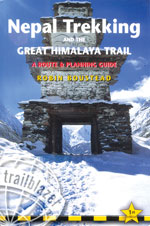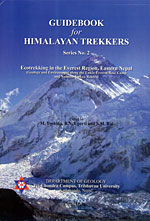 Nepal Trekking and the Great Himalayan Trail A Route & Planning Guide by Robin Boustead Trailblazer Publications, 2011 Price: $24.95 |
To the list of numerous Himalayan trekking guidebooks come two new ones this season that take hiking enthusiasts to routes less traveled by, and also to take a fresh look at established ones.
Nepal Trekking and the Great Himalayan Trail looks at the "holy grail" of the traverse of high-altitude passes not just in Nepal but from Bhutan right up to Kashmir. In Nepal, the trail takes about five months at one go, but can also be done in more manageable sections
It is well-established that inappropriate tourism fouls its own nest. Examples are some of the popular trekking routes in Nepal, where the influx has brought visitors and huge numbers of porters and support staff that overstretch the carrying capacity of fragile mountain valleys. Tourism provides some income but also brings inflation with the nett effect of making poverty worse. And lately, trekking trails in Nepal have been overtaken by highways, bringing both advantages and disadvantages.
The Great Himalayan Trail is a project designed to re-invent trekking tourism in Nepal, with the world's longest and highest trek. Boustead, who has done the great traverse himself, has put together the book from his own personal experience and sprinkles it with advice on local communities and their needs. Getting Trailblazer to add this title to its other handbooks like Indian Rail, The Silkroad, Trans-Siberian and Himalaya by Bike will provide a fresh new dimension to eco-trekking in Nepal.
Nepal Trekking is different from other trekking guides not just because it takes the various sections of The Great Himalayan Trail chapter-by-chapter, but also because it approaches trekking from a whole new perspective. It looks at an expedition's ecological footprint, how the arrival of outsiders can help rather than hinder local development and enlightens visitors about Nepal's incredible biological and ethnic diversity.
 Guidebook for Himalayan Trekkers Ecotrekking in the Everest Region M Yoshida, B N Upreti and S M Rai Department of Geology Tribhuvan University, 2011 192 pages |
The Guidebook for Himalayan Trekkers is published by the Department of Geology of Tribhuvan University can be best described as a naturalists' guide to trekking in the Everest region. Although it is called a guidebook, the book reads more like an academic report on the geology of the Khumbu. For the lay-trekker, the description and terminology may be too technical and dry.
Any native of Nepal or visitor must wonder at the cataclysmic collision of the continents 70 million years ago that thrust the Himalayan mountains nine km into the stratosphere. In that sense, one doesn't have to be a geologist to be curious about the tectonic forces that created this range and the aeons of erosion that sculpted our mountains and valleys. In that sense, everyone is an amateur geologist and this book is a quaint guide to understanding the geology, physiography, climate and vegetation of the Himalaya.
Having the handbook handy while walking from Namche to Phreiche, for example, will be an on-the-spot guide to interesting outcrops, explanations of rocks and boulders found along the way as well as pointing to the hazards of glacial lake outburst floods caused by global warming.
The authors even take us beyond base camp to the summit of Mt Everest to explain the amazing fact that the summit is made of yellow limestone. Microscopic examination of this rock shows remains of prehistoric marine microorganisms, forcing us to marvel that these rocks were once at the bottom of the Tethys Sea. We see the effects of the glacial retreat following the last ice age, the little ice age 800 years ago, as well as the accelerated thawing of the Himalaya today due to climate change.
If you can bear with the overdose of technical terminology and the academic language, the book will whet you appetite for geo-tectonics and may be worth the extra weight in your backpack.
Kunda Dixit
See also:
Off the beaten trek, BILLI BIERLING
The Great Himalayan Trail, ROBIN BOUSTEAD


